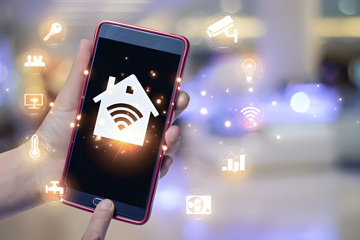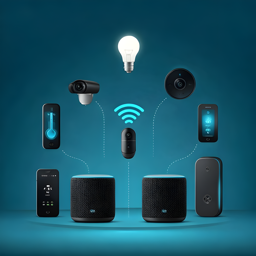ESP32 Gateway: Integrating Wi-Fi, BLE, and LoRa Solutions
Choosing the Best Wireless Tech for ESP32 Projects
Selecting the right wireless technology for your ESP32 Setting Up ESP32 as a Wi-Fi Access PointMaster ESP32 AP configuration with our step-by-step guide. Set up a secure, local IoT network using practical code examples and optimization tips.-based IoT project involves evaluating several critical factors: range, power consumption
Setting Up ESP32 as a Wi-Fi Access PointMaster ESP32 AP configuration with our step-by-step guide. Set up a secure, local IoT network using practical code examples and optimization tips.-based IoT project involves evaluating several critical factors: range, power consumption Connecting ESP32 to Cloud Services via Wi-FiDiscover how to connect your ESP32 to AWS, Azure, and Google Cloud using secure Wi-Fi. This guide covers setup, error handling, and low power strategies., costs, and implementation complexity. This guide consolidates insights from multiple sources to help you make an informed decision.
Connecting ESP32 to Cloud Services via Wi-FiDiscover how to connect your ESP32 to AWS, Azure, and Google Cloud using secure Wi-Fi. This guide covers setup, error handling, and low power strategies., costs, and implementation complexity. This guide consolidates insights from multiple sources to help you make an informed decision.
Table of Contents🔗
- Range
- Power Consumption
 Connecting ESP32 to Cloud Services via Wi-FiDiscover how to connect your ESP32 to AWS, Azure, and Google Cloud using secure Wi-Fi. This guide covers setup, error handling, and low power strategies.
Connecting ESP32 to Cloud Services via Wi-FiDiscover how to connect your ESP32 to AWS, Azure, and Google Cloud using secure Wi-Fi. This guide covers setup, error handling, and low power strategies. - Costs
- Complexity
- Key Takeaways
Range🔗
The range of a wireless technology determines how far your devices can communicate. Here’s a breakdown of the most common ESP32 Setting Up ESP32 as a Wi-Fi Access PointMaster ESP32 AP configuration with our step-by-step guide. Set up a secure, local IoT network using practical code examples and optimization tips.-compatible protocols:
Setting Up ESP32 as a Wi-Fi Access PointMaster ESP32 AP configuration with our step-by-step guide. Set up a secure, local IoT network using practical code examples and optimization tips.-compatible protocols:
| Technology | Range | Use Case |
|---|---|---|
| Wi-Fi | 50-100m (indoors), up to 150m (outdoors) | Short-range, high-bandwidth applications like home automation or video streaming. |
| Bluetooth/BLE | 10-100m (depending on class) | Short-range, low-power devices like wearables or proximity sensors. |
| LoRa | 2-15km (urban), up to 50km (rural) | Long-range, low-bandwidth applications like agricultural monitoring or asset tracking. |
| Zigbee | 10-100m (per node, mesh extends range) | Mesh networks for smart homes or industrial automation. |
| Sigfox | 10-50km (urban), up to 100km (rural) | Low-power, wide-area networks for remote monitoring. |
| NB-IoT | 1-10km (urban), up to 35km (rural) | Cellular-based IoT for applications like smart meters or fleet tracking. |
| 6LoWPAN/Thread | 10-100m (per node, mesh extends range) | Low-power, IPv6-based mesh networks for home automation. |
| NFC | <10cm | Ultra-short-range applications like contactless payments or device pairing. |
Short Range (≤100m):
- Wi-Fi, BLE, Zigbee, 6LoWPAN
 6LoWPAN Compression: Optimizing IPv6 for ESP32’s Constrained NetworksDiscover how 6LoWPAN smart compression optimizes IPv6 for ESP32 devices in IoT deployments, slashing packet overhead while boosting network efficiency.: Ideal for home automation, wearables, or indoor sensors.
6LoWPAN Compression: Optimizing IPv6 for ESP32’s Constrained NetworksDiscover how 6LoWPAN smart compression optimizes IPv6 for ESP32 devices in IoT deployments, slashing packet overhead while boosting network efficiency.: Ideal for home automation, wearables, or indoor sensors. - Wi-Fi
 Arquitetura ESP32: SoC dual-core, subsistemas RF integradosDiscover the ESP32’s dual-core prowess and integrated RF subsystems for efficient, innovative IoT applications—from smart homes to industrial sensors. Example:
Arquitetura ESP32: SoC dual-core, subsistemas RF integradosDiscover the ESP32’s dual-core prowess and integrated RF subsystems for efficient, innovative IoT applications—from smart homes to industrial sensors. Example:
// Check Wi-Fi signal strength on ESP32
int32_t rssi = WiFi.RSSI();
Serial.print("Signal strength: ");
Serial.println(rssi);
- LoRa, Sigfox
 Sigfox Message Encoding: Packing Sensor Data into 12-byte PayloadsLearn efficient data encoding techniques for Sigfox's constrained 12-byte payloads. Discover bitwise operations, structured encoding & CBOR strategies., NB-IoT, LTE: Suited for agriculture, smart cities, or asset tracking.
Sigfox Message Encoding: Packing Sensor Data into 12-byte PayloadsLearn efficient data encoding techniques for Sigfox's constrained 12-byte payloads. Discover bitwise operations, structured encoding & CBOR strategies., NB-IoT, LTE: Suited for agriculture, smart cities, or asset tracking. - LoRa
 ESP32 Multi-Protocol Gateways: Combining Wi-Fi, BLE, and LoRaDiscover how to build a multi-protocol ESP32 gateway integrating Wi-Fi, BLE, and LoRa for scalable IoT deployments in smart cities and industry. Example: Achieves 10km+ with line-of-sight but requires external modules (e.g., SX1276).
ESP32 Multi-Protocol Gateways: Combining Wi-Fi, BLE, and LoRaDiscover how to build a multi-protocol ESP32 gateway integrating Wi-Fi, BLE, and LoRa for scalable IoT deployments in smart cities and industry. Example: Achieves 10km+ with line-of-sight but requires external modules (e.g., SX1276).
Power Consumption🔗
Power consumption Connecting ESP32 to Cloud Services via Wi-FiDiscover how to connect your ESP32 to AWS, Azure, and Google Cloud using secure Wi-Fi. This guide covers setup, error handling, and low power strategies. is critical for battery-powered devices. Here’s how the technologies stack up:
Connecting ESP32 to Cloud Services via Wi-FiDiscover how to connect your ESP32 to AWS, Azure, and Google Cloud using secure Wi-Fi. This guide covers setup, error handling, and low power strategies. is critical for battery-powered devices. Here’s how the technologies stack up:
| Technology | Power Consumption | Best For |
|---|---|---|
| Wi-Fi | High | Devices with access to consistent power, like smart plugs or cameras. |
| Bluetooth/BLE | Low to Moderate | Wearables, beacons, and other low-power devices. |
| LoRa | Very Low | Long-range sensors that need to run for years on a single battery. |
| Zigbee | Low | Mesh networks with battery-powered nodes like sensors or switches. |
| Sigfox | Very Low | Remote sensors with infrequent data transmission. |
| NB-IoT | Moderate | Cellular IoT devices with periodic data uploads. |
| 6LoWPAN/Thread | Low | Battery-powered mesh networks for smart homes. |
| NFC | Very Low | Passive or low-power applications like access control. |
Optimization Tips:
- BLE
 Native Protocols: Wi-Fi (2.4 GHz), Bluetooth Classic, and BLEExplore ESP32 connectivity with Wi-Fi, Bluetooth Classic, and BLE. Learn implementation tips and best practices for IoT projects.: Use
Native Protocols: Wi-Fi (2.4 GHz), Bluetooth Classic, and BLEExplore ESP32 connectivity with Wi-Fi, Bluetooth Classic, and BLE. Learn implementation tips and best practices for IoT projects.: Use ESP_BLE_ADV_FLAG_LIMIT_DISCfor intermittent advertising. - LoRa
 ESP32 Multi-Protocol Gateways: Combining Wi-Fi, BLE, and LoRaDiscover how to build a multi-protocol ESP32 gateway integrating Wi-Fi, BLE, and LoRa for scalable IoT deployments in smart cities and industry.: Set spreading factor
ESP32 Multi-Protocol Gateways: Combining Wi-Fi, BLE, and LoRaDiscover how to build a multi-protocol ESP32 gateway integrating Wi-Fi, BLE, and LoRa for scalable IoT deployments in smart cities and industry.: Set spreading factor Adaptive Data Rate (ADR) Optimization for LoRaWAN on ESP32Optimize your IoT network with our ADR tutorial for ESP32 in LoRaWAN. Learn dynamic transmission tuning, power management, and troubleshooting strategies. (SF) to 9-12 for range vs. power trade-off.
Adaptive Data Rate (ADR) Optimization for LoRaWAN on ESP32Optimize your IoT network with our ADR tutorial for ESP32 in LoRaWAN. Learn dynamic transmission tuning, power management, and troubleshooting strategies. (SF) to 9-12 for range vs. power trade-off. - Sigfox
 Sigfox Message Encoding: Packing Sensor Data into 12-byte PayloadsLearn efficient data encoding techniques for Sigfox's constrained 12-byte payloads. Discover bitwise operations, structured encoding & CBOR strategies.: Send 140 messages/day (Sigfox
Sigfox Message Encoding: Packing Sensor Data into 12-byte PayloadsLearn efficient data encoding techniques for Sigfox's constrained 12-byte payloads. Discover bitwise operations, structured encoding & CBOR strategies.: Send 140 messages/day (Sigfox Sigfox Message Encoding: Packing Sensor Data into 12-byte PayloadsLearn efficient data encoding techniques for Sigfox's constrained 12-byte payloads. Discover bitwise operations, structured encoding & CBOR strategies.’s daily limit).
Sigfox Message Encoding: Packing Sensor Data into 12-byte PayloadsLearn efficient data encoding techniques for Sigfox's constrained 12-byte payloads. Discover bitwise operations, structured encoding & CBOR strategies.’s daily limit). - Wi-Fi
 Arquitetura ESP32: SoC dual-core, subsistemas RF integradosDiscover the ESP32’s dual-core prowess and integrated RF subsystems for efficient, innovative IoT applications—from smart homes to industrial sensors.: Use
Arquitetura ESP32: SoC dual-core, subsistemas RF integradosDiscover the ESP32’s dual-core prowess and integrated RF subsystems for efficient, innovative IoT applications—from smart homes to industrial sensors.: Use esp_deep_sleep_start()between transmissions.
Costs🔗
Costs include both hardware and operational expenses (e.g., data plans for cellular technologies):
| Technology | Hardware Cost | Operational Cost | Best For |
|---|---|---|---|
| Wi-Fi | Low | Free (no data plans) | Projects with existing Wi-Fi infrastructure. |
| Bluetooth/BLE | Low | Free | Short-range, low-cost devices. |
| LoRa | Moderate | Low (if using private networks) | Long-range, low-bandwidth applications. |
| Zigbee | Moderate | Free | Mesh networks with multiple nodes. |
| Sigfox | Moderate | Subscription-based | Wide-area, low-power applications. |
| NB-IoT | High | Subscription-based | Cellular IoT with global coverage. |
| 6LoWPAN/Thread | Moderate | Free | IPv6-based mesh networks. |
| NFC | Low | Free | Ultra-short-range applications. |
Hardware Examples:
- Low Cost ($): BLE, Wi-Fi (native on ESP32
 Setting Up ESP32 as a Wi-Fi Access PointMaster ESP32 AP configuration with our step-by-step guide. Set up a secure, local IoT network using practical code examples and optimization tips.).
Setting Up ESP32 as a Wi-Fi Access PointMaster ESP32 AP configuration with our step-by-step guide. Set up a secure, local IoT network using practical code examples and optimization tips.). - Moderate ($$): LoRa (SX1276 module: ~$5), Zigbee (CC2652P
 Adding Zigbee to ESP32: CC2652P/CC2652R Modules and Z-Stack FirmwareDiscover how to extend ESP32 with Zigbee using CC2652 modules. Our guide explains wiring, firmware setup, and secure IoT network configuration.: ~$8).
Adding Zigbee to ESP32: CC2652P/CC2652R Modules and Z-Stack FirmwareDiscover how to extend ESP32 with Zigbee using CC2652 modules. Our guide explains wiring, firmware setup, and secure IoT network configuration.: ~$8). - High ($$$): NB-IoT modules (Quectel BC66
 Using Quectel BC66/BG96 Modules with ESP32 for NB-IoT ConnectivityExplore our detailed tutorial on integrating Quectel BC66/BG96 with ESP32 for low-power, reliable NB-IoT connectivity. Learn hardware setup and AT commands.: ~$20), LTE modems.
Using Quectel BC66/BG96 Modules with ESP32 for NB-IoT ConnectivityExplore our detailed tutorial on integrating Quectel BC66/BG96 with ESP32 for low-power, reliable NB-IoT connectivity. Learn hardware setup and AT commands.: ~$20), LTE modems.
Complexity🔗
Complexity refers to the ease of implementation, including hardware setup Zigbee Green Power: Ultra-Low-Power Energy Harvesting SolutionsDiscover how ZGP enables battery-free IoT devices through energy harvesting with ESP32 integrations, supporting smart home and industrial applications., software integration, and maintenance:
Zigbee Green Power: Ultra-Low-Power Energy Harvesting SolutionsDiscover how ZGP enables battery-free IoT devices through energy harvesting with ESP32 integrations, supporting smart home and industrial applications., software integration, and maintenance:
| Technology | Complexity | Key Challenges |
|---|---|---|
| Wi-Fi | Low to Moderate | Security configuration, interference management. |
| Bluetooth/BLE | Low | Profile and service setup, coexistence with Wi-Fi. |
| LoRa | Moderate | Configuring spreading factors, gateway setup. |
| Zigbee | Moderate | Mesh network configuration, device compatibility. |
| Sigfox | Low | Limited payload size, downlink constraints. |
| NB-IoT | High | Modem integration, carrier provisioning. |
| 6LoWPAN/Thread | Moderate | IPv6 stack configuration, mesh routing. |
| NFC | Low | Limited range, antenna tuning. |
Code Snippets:
lorawan.join(APP_EUI, APP_KEY);
zcl_processIncomingMsg(&zclMsg);
otInstanceInitSingle();
modem.sendAT("+COPS?");
Key Takeaways🔗
1. Battery Life vs. Range: BLE and Zigbee Interfacing ESP32 with Zigbee3.0 Devices (Xiaomi, Philips Hue)Unlock seamless smart home integration by following our detailed guide on bridging ESP32 with external Zigbee modules for reliable IoT solutions. excel in low-power, short-range scenarios; LoRa/Sigfox dominate long-range.
Interfacing ESP32 with Zigbee3.0 Devices (Xiaomi, Philips Hue)Unlock seamless smart home integration by following our detailed guide on bridging ESP32 with external Zigbee modules for reliable IoT solutions. excel in low-power, short-range scenarios; LoRa/Sigfox dominate long-range.
2. Cost vs. Scalability: Native Wi-Fi/BLE minimize costs for small deployments; NB-IoT Firmware Updates over NB-IoT: Delta Updates with ESP32’s Dual PartitionDiscover how delta firmware updates via NB-IoT optimize ESP32 device performance by minimizing data usage and ensuring secure, swift OTA transitions./LTE suit large-scale industrial projects.
Firmware Updates over NB-IoT: Delta Updates with ESP32’s Dual PartitionDiscover how delta firmware updates via NB-IoT optimize ESP32 device performance by minimizing data usage and ensuring secure, swift OTA transitions./LTE suit large-scale industrial projects.
3. Hybrid Solutions Zigbee Green Power: Ultra-Low-Power Energy Harvesting SolutionsDiscover how ZGP enables battery-free IoT devices through energy harvesting with ESP32 integrations, supporting smart home and industrial applications.: Combine protocols (e.g., ESP32
Zigbee Green Power: Ultra-Low-Power Energy Harvesting SolutionsDiscover how ZGP enables battery-free IoT devices through energy harvesting with ESP32 integrations, supporting smart home and industrial applications.: Combine protocols (e.g., ESP32 Setting Up ESP32 as a Wi-Fi Access PointMaster ESP32 AP configuration with our step-by-step guide. Set up a secure, local IoT network using practical code examples and optimization tips. + LoRa for edge-to-cloud) to balance trade-offs.
Setting Up ESP32 as a Wi-Fi Access PointMaster ESP32 AP configuration with our step-by-step guide. Set up a secure, local IoT network using practical code examples and optimization tips. + LoRa for edge-to-cloud) to balance trade-offs.
- Decision Flowchart:
Is long-range critical?
├─ Yes → Does it need cellular? → LTE/NB-IoT
├─ No → Is ultra-low power essential? → Sigfox/LoRa
└─ Maybe → Use Wi-Fi with mesh (ESP-MESH)
By understanding the trade-offs between range, power consumption Connecting ESP32 to Cloud Services via Wi-FiDiscover how to connect your ESP32 to AWS, Azure, and Google Cloud using secure Wi-Fi. This guide covers setup, error handling, and low power strategies., costs, and complexity, you can select the optimal wireless technology for your ESP32 project. Happy connecting!
Connecting ESP32 to Cloud Services via Wi-FiDiscover how to connect your ESP32 to AWS, Azure, and Google Cloud using secure Wi-Fi. This guide covers setup, error handling, and low power strategies., costs, and complexity, you can select the optimal wireless technology for your ESP32 project. Happy connecting!
Author: Marcelo V. Souza - Engenheiro de Sistemas e Entusiasta em IoT e Desenvolvimento de Software, com foco em inovação tecnológica.
References🔗
- Arduino Forum: forum.arduino.cc
- Arduino IDE Official Website: arduino.cc
- ESP-IDF Programming Guide: docs.espressif.com/projects/esp-idf
- ESP32 Arduino Core Documentation: docs.espressif.com/projects/arduino-esp32
- Espressif Documentation: docs.espressif.com


 7 months ago
7 months ago
 7 months ago
7 months ago
 7 months ago
7 months ago
 7 months ago
7 months ago
 7 months ago
7 months ago
 7 months ago
7 months ago
 7 months ago
7 months ago
 7 months ago
7 months ago
 7 months ago
7 months ago
 7 months ago
7 months ago
 7 months ago
7 months ago
 7 months ago
7 months ago
 7 months ago
7 months ago
 7 months ago
7 months ago
 7 months ago
7 months ago
 8 months ago
8 months ago
 7 months ago
7 months ago
 7 months ago
7 months ago
 7 months ago
7 months ago
 7 months ago
7 months ago
 7 months ago
7 months ago
 7 months ago
7 months ago
 7 months ago
7 months ago